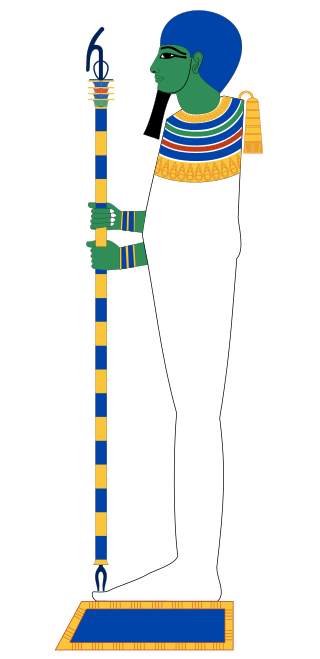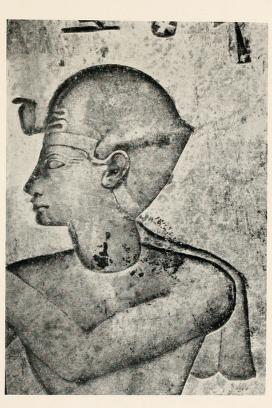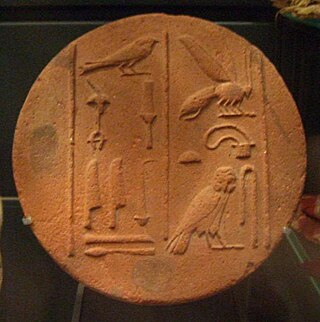Related Research Articles

Memphis, or Men-nefer, was the ancient capital of Inebu-hedj, the first nome of Lower Egypt that was known as mḥw ("North"). Its ruins are located in the vicinity of the present-day village of Mit Rahina, in markaz (county) Badrashin, Giza, Egypt. This modern name is probably derived from the late Ancient Egyptian name for Memphis mjt-rhnt meaning "Road of the Ram-Headed Sphinxes".

Ptah is an ancient Egyptian deity, a creator god and patron deity of craftsmen and architects. In the triad of Memphis, he is the husband of Sekhmet and the father of Nefertem. He was also regarded as the father of the sage Imhotep.

Seker is a hawk or falcon god of the Memphite necropolis in the Ancient Egyptian religion, who was known as a patron of the living, as well as a god of the dead. He is also in some accounts a solar deity as for The Temple of Seker in Memphis.

In ancient Egyptian religion, Apis or Hapis, alternatively spelled Hapi-ankh, was a sacred bull or multiple sacred bulls worshiped in the Memphis region, identified as the son of Hathor, a primary deity in the pantheon of ancient Egypt. Initially, he was assigned a significant role in her worship, being sacrificed and reborn. Later, Apis also served as an intermediary between humans and other powerful deities.
The djed, also djt is one of the more ancient and commonly found symbols in ancient Egyptian religion. It is a pillar-like symbol in Egyptian hieroglyphs representing stability. It is associated with the creator god Ptah and Osiris, the Egyptian god of the afterlife, the underworld, and the dead. It is commonly understood to represent his spine.

King Usermaatre SetepenreShoshenq III of the 22nd Dynasty ruled for 39 years according to contemporary historical records. Two Apis Bulls were buried in the fourth and 28th years of his reign and he celebrated his Heb Sed Jubilee in his regnal year 30. He was not a son of Osorkon II but instead a grandson through his dead father prince Takelot. As he was only a grandson, his cousin Takelot II contested his succession and Egypt was divided. He married his aunt Tjesbastperu to strengthen his claim. He outlived his first five sons and was thus succeeded by his 6th son Shoshenq IV, who later died childless as well and was succeeded by Shoshenq III's 7th son Pami.

Neterkheperre or Netjerkheperre-Setepenamun Siamun was the sixth pharaoh of Egypt during the Twenty-first Dynasty. He built extensively in Lower Egypt for a king of the Third Intermediate Period and is regarded as one of the most powerful rulers of the Twenty-first Dynasty after Psusennes I. Siamun's prenomen, Netjerkheperre-Setepenamun, means "Divine is The Manifestation of Ra, Chosen of Amun" while his name means 'son of Amun.'

Thutmose was the eldest son of Pharaoh Amenhotep III and Queen Tiye, who lived during the Eighteenth Dynasty of Egypt. His early death led to the reign of Akhenaten, his younger brother—as the successor to the Egyptian throne—and the intrigues of the century leading up to Ramesses II, the start and ultimately the failure of Atenism, the Amarna letters, and the changing roles of the kingdom's powers.

The High Priest of Ptah was sometimes referred to as "the Greatest of the Directors of Craftsmanship". This title refers to Ptah as the patron god of the craftsmen.

Ptahemhat called Ty was High Priest of Ptah in Memphis during the time of 18th Dynasty reign of Tutankhamen and/or Ay.
Ptahmose was High Priest of Ptah in Memphis during the time of Thutmose IV and in the beginning of the reign of Amenhotep III.
Neterkheperre Meryptah called Pipi II was a High Priest of Ptah during the 21st Dynasty. He was High priest during the reigns of Psusennes I, Amenemope, Osochor and Siamun.
Ashakhet II was a High Priest of Ptah during the 21st Dynasty. He served during the reigns of Siamun and Psusennes II.

Sehetepebreankh-nedjem was an ancient Egyptian official with the titles royal sealer, foremost of action, Sem-priest and Great one of the leaders of craftsmen. The latter title is that of the High Priest of Ptah. The god Ptah was the deity of arts and crafts and therefore, the high priest of Ptah had a title related to crafts. Sehetepebreankh-nedjem is known from a group statue showing him, his son and his grandson. The statue was dedicated by his son Nebpu, who was also High Priest of Ptah. The statue is datable by style to the end of the Twelfth Dynasty and is now in the Louvre. The statue was bought in 1816 by the Louvre and is most likely from Memphis. This city was the major cult centre for Ptah.

The ancient Egyptian noble Prehotep II was Vizier in the latter part of the reign of Ramesses II, during the 19th Dynasty.
This page list topics related to ancient Egypt.
Thutmose was an ancient Egyptian vizier under Amenhotep III, during the 18th Dynasty.

The Stela of Pasenhor, also known as Stela of Harpeson in older literature, is an ancient Egyptian limestone stela dating back to the Year 37 of pharaoh Shoshenq V of the 22nd Dynasty. It was found in the Serapeum of Saqqara by Auguste Mariette and later moved to The Louvre, where it is still.

Ipy, also transliterated as Apy, was a court official from the time of Amenhotep III and Akhenaten during the Egyptian 18th Dynasty. Ipy was High Steward of Memphis, and a royal scribe.

Iyri was an ancient Egyptian priest in the function of a High Priest of Ptah, who was in office under king Seti II in the Egyptian Nineteenth Dynasty.
References
- ↑ Berta Porter, Rosalind L. B. Mossː Topographical Bibliography of Ancient Egyptian Hieroglyphic Texts, Reliefs, and Paintings, III (2). Memphis (second edition) Oxford 1981, p. 706 online
- ↑ B. Pörtner, A. Wiedemannː Aegyptische Grabreliefs aus der Grossherzoglichen Altertümer-Sammlung zu Karlsruhe, Strassburg 1906, p. 32, pl. VII
- ↑ André Jolles: Die ägyptisch-mykenischen Prunkgefässe, in: Jahrbuch des Deutschen Archäologischen Instituts, 23 (1908). p. 249, fig. 50 online